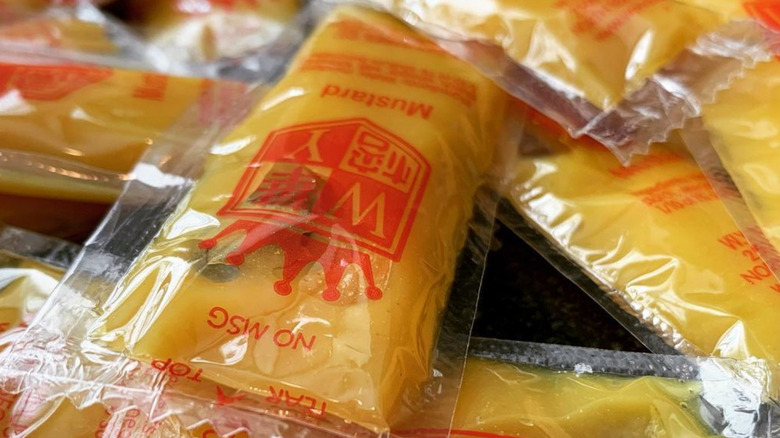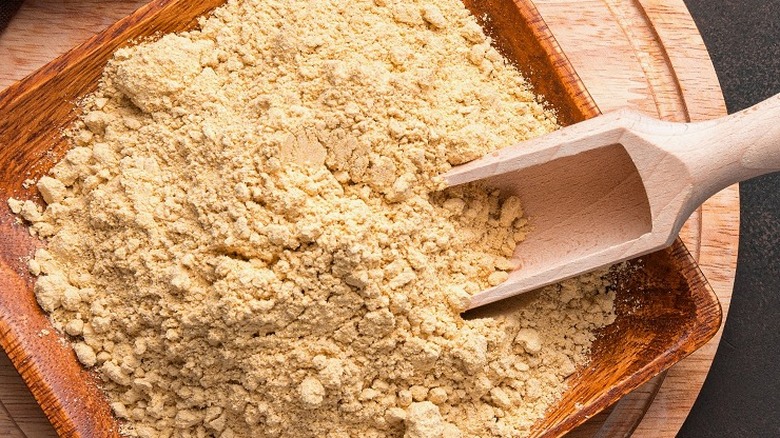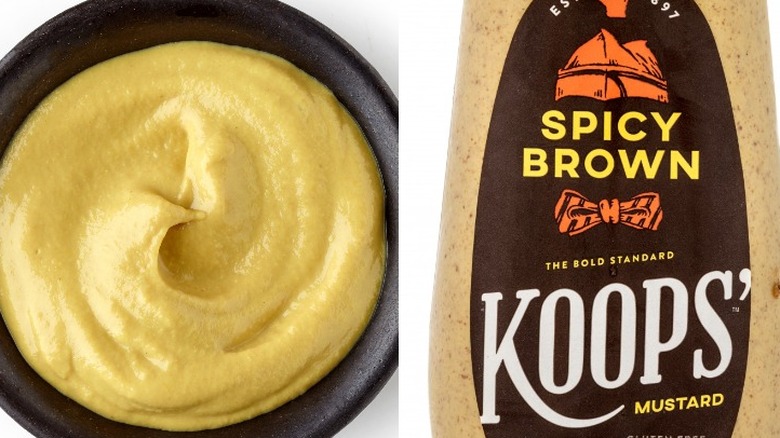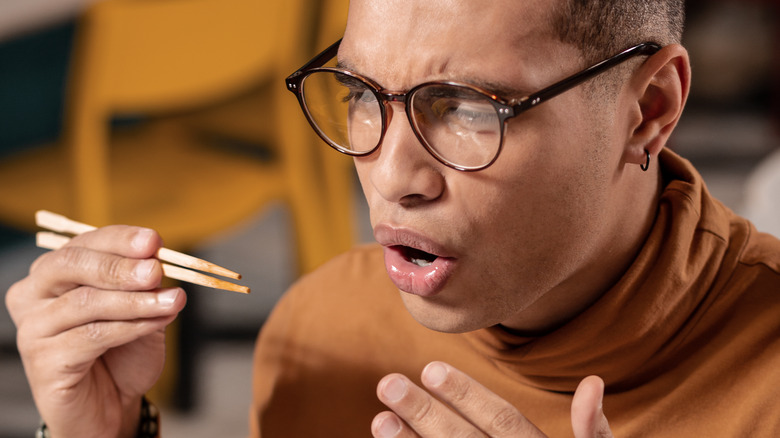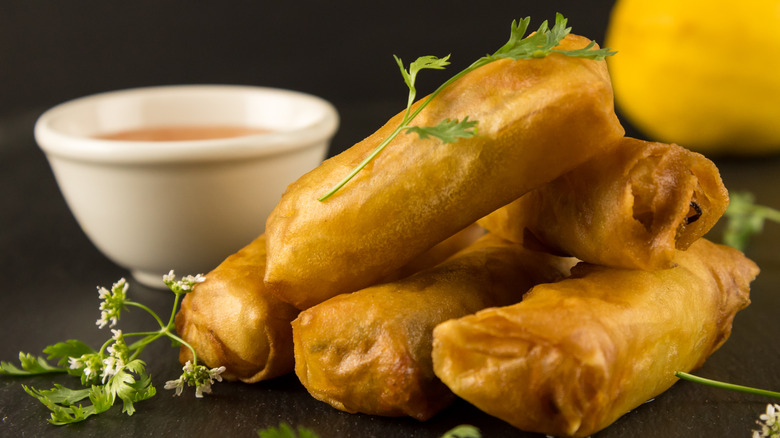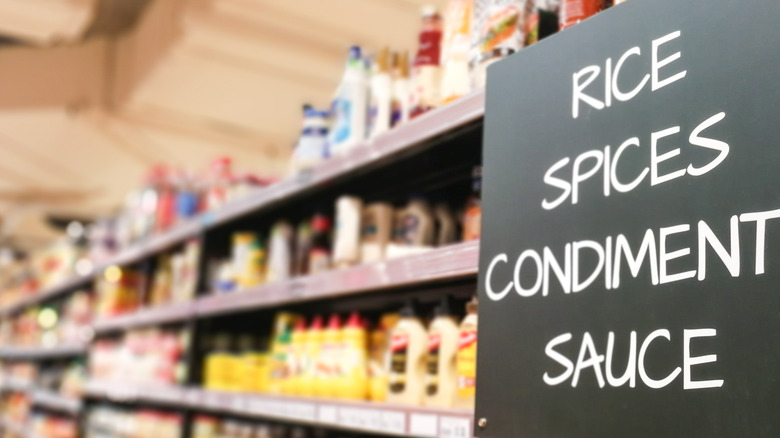What Is Chinese Hot Mustard And What Makes It So Spicy?
We may receive a commission on purchases made from links.
The little yellow packets of mustard at the bottom of your Chinese takeout bag are not nearly as innocent as they look. Proceed with caution when dipping your egg roll or wonton strips into this pungent condiment, because it will set your mouth and sinuses on fire. It's definitely not your average, hotdog-topping yellow mustard, and it's so much more intense than even spicy brown. So what is Chinese mustard exactly, and why is it so dang spicy?
SPICEography shares that like all mustards, this one is made from mustard seeds — specifically, brown mustard seeds. (There are two other kinds as well: white and black.) Brown mustard seeds come from the mustard plant variety Brassica juncea. Other vegetables in the Brassica plant family include turnips, broccoli, Brussels sprouts, and stronger flavored members like radishes, arugula, and horseradish (via Britannica). What sets Chinese mustard apart is not only the kind of seed it comes from, but the way it's prepared. Here's a closer look at this fiery sauce.
How is Chinese hot mustard made?
Food Republic shares that brown mustard seeds are stronger in flavor than white mustard seeds, and slightly milder than black. The white variety (which are sometimes referred to as yellow seeds) are used to make milder mustards like classic yellow or Dijon styles, while brown and black are used for spicier mustards. Mustard seeds are ground down into powders ranging from coarse to very fine, depending on the type of mustard desired. Once ground, liquids are added to the powder. In some mustards, acidic ingredients like vinegars not only contribute to the flavor of the finished mustard, but do two other important things as well: They help tamp down the spiciness of the seeds to create a pungent flavor that's not too overwhelming, and they stabilize the mustard so that the potency doesn't fade over time.
Chinese mustard begins with brown mustard seeds, just like many other mustards with a kick, including spicy brown and whole grain. According to Spruce Eats, the seeds are dried and then ground into a fine powder. The powder is then mixed with cold water — and this is key to getting that heat. Cold water activates the enzymes and sulfur compounds naturally present in the seeds, and the heat really builds since there are no acidic ingredients to temper it. After a short rest, the mustard is ready.
Chinese hot mustard versus spicy brown mustard
The sinus-searing heat is the defining characteristic of Chinese mustard. SPICEography notes that since high temperatures can diminish the compounds in mustard seeds that are responsible for this spiciness, the ground powder is mixed with cold water into a smooth sauce. After a little time to let the heat develop, it's usually used right away since the pungency will fade with time. Spruce Eats shares that bottled, premade Chinese mustards may include some vinegar and starch to help stabilize the flavor for longer storage.
Spicy brown mustard is made with the same brown mustard seeds as Chinese mustard, but the seeds are soaked in vinegar before the mustard is prepared (via Serious Eats.) Spicy brown will have some of the spiciness of the mustard seeds, but that heat is tempered by this vinegar soak. Spicy brown also has some texture, which comes from leaving the bran in the seeds. Serious Eats also notes that spices like ginger and nutmeg are often added to spicy brown mustards. So although spicy brown has a kick, it has far less heat than Chinese mustard, plus more texture and a different flavor profile.
What does it taste like?
When you blend powdered mustard seeds with cold water and nothing else — no acidic vinegars, sugar, sweet honey, beer, or spices, you're really only left with one thing: The heat. Spruce Eats says that while you can sometimes catch a tanginess in a taste of Chinese mustard, what you primarily get is the intense rush of fire that seems to skip right past your tongue to rush into and through your sinuses. If you ever want to clear out a stubborn head cold that's clogging your nose, a bite of Chinese hot mustard will do the trick!
Spices, Inc. says that the experience is similar to that of eating horseradish or wasabi, in that they share a flavor that is very "sharp" and that sends a quick rush of spiciness to your palate. This is not all that surprising when you remember that brown mustard seeds and horseradish come from the same family of mustard greens. Season With Spice says that eating Chinese mustard will take you back to childhood in an unexpected way: "screaming one moment, jumping up and down with excitement the next, and crying like a baby when it's all over."
How to use Chinese hot mustard
Because Chinese mustard is so extremely hot, it tends to be used more sparingly than other mustards so that the heat won't overwhelm the rest of the food. Spruce Eats shares that Chinese mustard is a popular dipping sauce for meats and fried appetizers like eggrolls, wontons, and crab rangoon. It's often served alongside sweeter sauces that can act as a foil to the heat.
To make your own fresh Chinese hot mustard, mix equal parts of the mustard powder with cold water. (Cold water is important here, to get that authentic level of fiery heat.) Let the mixture rest for about an hour and the mustard is ready to use. Of course, making your own means you have the option of playing around with it a little, and you can add other ingredients to mellow the heat or to create a more complex flavor. Season With Spice's suggestions for add-ins include honey, rice vinegar, and white pepper. You can also use Chinese mustard in dry form. Spices, Inc. recommends adding the dry mustard powder to marinades, dry rubs, and even to meaty Cornish pastie fillings.
Where to buy Chinese hot mustard
When looking for Chinese hot mustard at your grocery store, check both the international aisle and the spice aisle. The powdered mustard is often sold in small canisters (S&B is one brand) and may labeled as "Chinese Hot", Chinese-style Hot", or just as "Hot Mustard" (via Spruce Eats). Bulk spice stores and natural food stores are also great places to check for the powdered form, which can be quickly and easily mixed with cold water to create the mustard. Though freshly-made hot mustard will lose its potency more quickly, the quick prep time means you can make just the amount you need any time you want it.
There are bottled Chinese hot mustards too, which Spruce Eats notes may contain other ingredients like vinegar to make the mustard last longer, and turmeric to give it a more mustardy color. Brands of bottled Chinese hot mustard include Ka-Me and Ty Ling. And of course, when you order at sit-down or take-out Chinese restaurants, ask for hot mustard to be included with your food. Dip your spring rolls, fried shrimp, and spareribs into the pungent mustard — and get ready for the fire!
